Minerals & Rocks
And
Bedrock & Sediment
DEFINITIONS:
Minerals
A mineral is defined as a naturally occurring, inorganic element or compound having an orderly internal structure and characteristic chemical composition and physical properties. Some would argue that a mineral should also have a characteristic crystal form, but we will not.
Rocks
A rock is defined as a naturally occurring, nonliving, firm and coherent aggregate mass ofone or more minerals or solid organic material. Some would not include solid organic material as rock, but we live in Utah, and a solid organic material-coal-is our state rock. Who would want to argue that our state legislators do not know a rock when they see one?
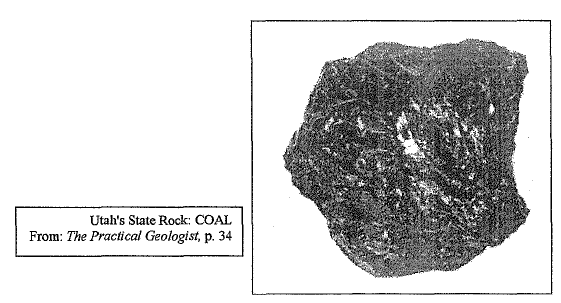
Atoms are building blocks of crystals. Crystals are building blocks of many minerals. Minerals are the building blocks of rocks.
Bedrock
Bedrock is a portion ofthe intact and continuous part ofthe Earth's crust. Life as we know it would not be possible on earth without the heat from the inside of the Earth, but the inside of the Earth immediately below the outer rocky crust is inhospitable. The crust of the Earth, the thin, continuous rocky skin that separates the molten portion of the Earth from the atmosphere is solid rock called bedrock. In mountainous area of Salt Lake County bedrock is at or within a few feet of the surface. Bedrock underlies all of the valley areas of Salt Lake County although it may be hundreds or even thousands of feet below the land surface. Where bedrock is exposed at the surface, we call it an outcrop. Where bedrock is not exposed at the surface, we call it buried bedrock.
Sediment
Sediment consists ofsolid fragments of rock that have been transported by water, wind, ice, or gravity andlor solid materials precipitated chemically from water or secreted by organisms. Sediment accumulates like a blanket across portions of the Earth's crust. Sediment is not "firm and coherent." The dirt, sand, clay, and gravels we build most homes and schools on in Salt Lake County is sediment. Most sediments will eventually become firm and coherent but it may take millions of years for geologic processes to bury and transform the sediments into bedrock.
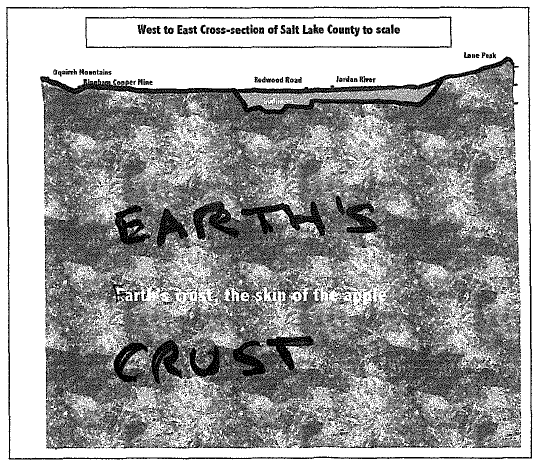
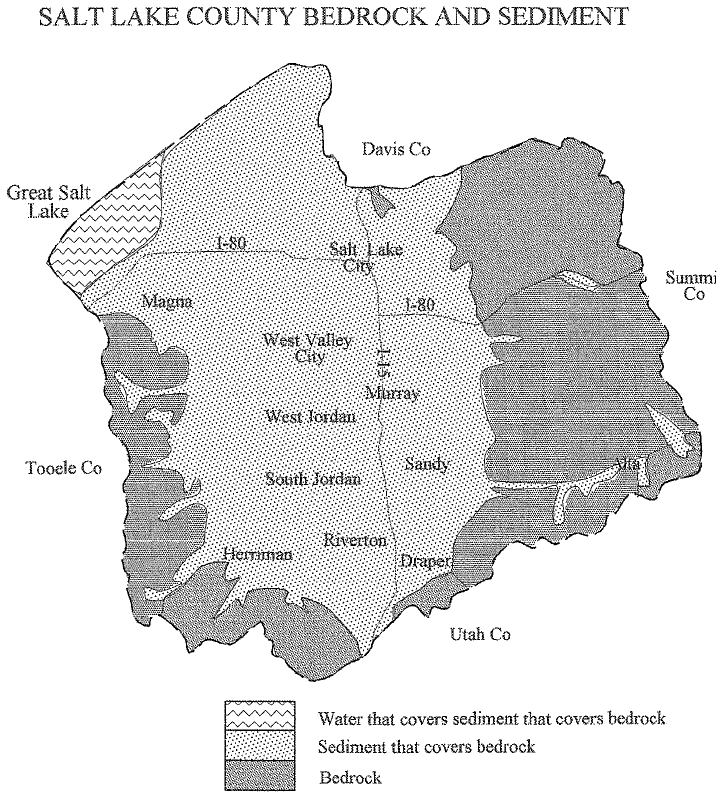
DISTINCTIONS:
CAUTION:
English is a wonderful language but sometimes a word has more than one meaning. We look at the "rock" (bedrock) that makes up the mountains and we look at a "rock" (sediment) lying on the ground. So we use the word "rock" to mean two different things. This can confuse your students.
A child hands you a rock.
It once was bedrock.
It now is a piece of sediment.
It is composed of minerals.
Congratulations!
You are already on your way to learning the story the rock tells. When a child hands you a rock, they are handing you a piece of sediment, either a cobble or a pebble unless someone took the rock from an outcrop of bedrock. With it they are giving you the opportunity of a teaching moment. With confidence and enthusiasm you begin to relate the story the rock tells. Go for it!
Your challenge: To tell the stories the rock tells.
- Story 1: how did the rock get where it is?
- Story 2: what kind of bedrock did the rock get eroded from?
- Story 3: where is the rock on its journey of the rock cycle?
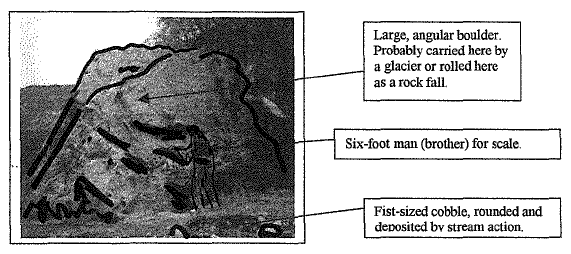
The size of the rock tells you....
Hints ... how much energy does it take to roll or move this rock? what size stream and how turbulent would the stream moving this rock be? Could waves along a beach have rounded it or was it carried in a rock-mud slurry? Share your thoughts. Is it fresh off an outcrop of bedrock. Size alone doesn't tell the whole story but it will get you and your student thinking.
The shape of the rock tells you...
Hints... how does a rock's shape change as it bounces along and is clunked against other rocks in a stream bed? Look for "roundness" "smoothness." Stream action knocks bits and pieces off rocks so they get very smooth and rounded. Rock-mud slurries carry rocks, sometimes big ones, but they don't get rounded the way rocks in streams or on beaches get rounded.
Its location, its relationship to its neighbors tells you....
Hints... look at the sizes of the rock's neighbors. This is called sorting.
- Well sorted: Is the deposit all the same size and shape like the sand of a beach.
- Poorly sorted: Is the deposit a very mixed bag... boulders and sand and gravel and clay. Poor sorting is very typical of landslides or rockmud slurries or deposits bulldozed by glaciers.
- Gradationally sorted: Is the deposit not really well-sorted or poorly sorted but with gradations in size within layers and among layers. Graded sorting is very typical of stream deposits and some beach deposits.
Caution: Beware to not get confused by the construction activities of humans. If a deposit looks jumbled, entertain the possibility that part of your rock's story includes being disturbed by human activities.
Use your instincts and your own awareness of depositional environments you've known and loved. Does the sediment LOOK like a stream bed? Or a beach deposit? Or a dump from a glacier? Or messed up by humans?
How to observe a rock... how to describe a rock.
A rock gives you many clues to its history. In this chapter, we want you to develop your detective-like skills of observation. Encourage your students to look for the most important clues that will help you answer "what is this rock?"
Your challenge: To tell the stories the rock tells.
- Story 1: how did the rock get where it is?
- Story 2: what kind of bedrock did the rock get eroded from?
- Story 3: where is the rock on its journey of the rock cycle?
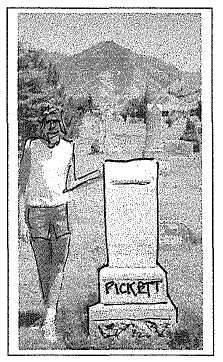
Reminder: virtually every piece of rock your students hand you is a piece of sediment that came from bedrock. The purpose of this chapter is for you to observe the clues that will help you tell Story 1 and Story 2. Ifyou can tell Story 2 you can tell Story 3.
(If it is just too frustrating to first learn about observation and then learn the rock types ... and you just have to know what sedimentary, metamorphic and igneous rocks are... it's Okay to skip forward to Chapter Five, read about the rock types, and come back to this one. But for those of you who can stand the suspense, we encourage you to learn to observe before you attempt to interpret what you are observing.)
One part of good science is good observation. Another part is interpretation. This chapter is meant to coach you on how to encourage systematic observation: How to observe with a purpose. Chapters Three through Eight will coach you on how to interpret what you see: How you take the clues and tell the stories.
Rocks are all around us even in urban Salt Lake County. Cemeteries are great places to find beautifully displayed, diverse rock types. Virtually every school in Salt Lake County has examples of sedimentary, metamorphic and igneous rocks nearby in a cemetery. The older the cemetery the better. Tombstones make for good teaching moments. Of course, be respectful. NO destructive hammering, or chemical experiments on gravestones.
Observing rocks in the field (even in a cemetery).
When you observe a rock however large or small, make two kinds of observations...
- The coarse picture: 3 to 10 feet from the rock, and
- The fine picture: 1 to 3 inches from the rock preferably with a hand lens.
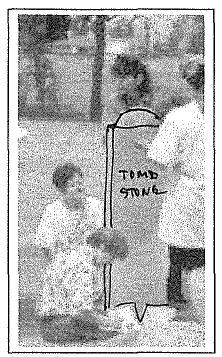
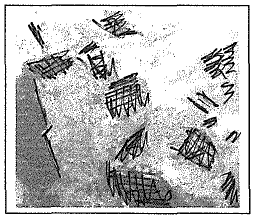
To observe the key clues a rock can tell you, you must do both.
- You need to look at patterns that you see from 3 to 10 feet
- You need to look at individual grains and crystals, that you see at 1 to 3 inches or through a hand-lens.
If you are NOT in a cemetery, ifyou are in the field:
Geologists use rock hammers to break off pieces of rock and give them a "fresh rock/ace' to examine. The constituent grains and crystals offresh surfaces are generally easier to distinguish than those of weathered surfaces. The way a rock breaks also tells you about the rock... does it break along a layer or does it break along a crack that crosses the layers at an angle? Is the surface of the broken surface smooth or do you feel the roughness of individual or irregular grains?
Caution: rock hammers are dangerous. Flying rock chips can blind. Encourage students to wear safety glasses. Splitting rocks with rock hammers is an impractical classroom activity.
The COARSEpicture: What you see at 3 to 10 feet
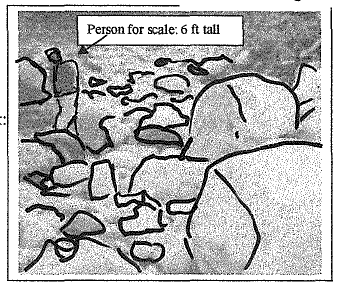
Observing with a purpose:
THE CLUES:
What is the overall appearance of the rock:
- its size?
- its shape? "
- how difficult to crack open?
- its general color? and
- the pattern of its constituent colors?
Why do these characteristics matter?
SIZE AND SHAPE
Give the best clues for Story 1: the immediate past history of the piece of sediment. How did the rock get to where your student found it?
If it is huge relatively rough rock, it may have recently been part of a bedrock outcrop, or been a boulder carried by a glacier.
If it is a little, smoothed pebble, it may have been in an active stream bed and is all that remains of a boulder.
If it is a tombstone, it has a history of human intervention. The date on the tombstone may indicate how long it has been exposed to weathering right where it is now.
SIZE:

SHAPE'

SO ... you look around at where the rock is, and you hypothesize that the rock got here:
- Carried in by human intervention,
- Carried in by water, examples: stream action, lake action, debris flow
- Carried in by ice: glacial action,
- Carried in by wind
- Rolled or fell in response to gravity.
MORE COARSE OBSERVATIONS:
CLUES FOR STORY 2: (what kind of bedrock was the rock eroded from?)
Remember: These clues are not so easy to decipher. Try to consider all the clues (coarse and fine) before jumping to a conclusion.
HOW DIFFICULT TO CRACK OPEN (you don't need to break the rock open with a rock hammer to guess how difficult it will be to break it up.)


GENERAL COLOR (gives clues to the rock's bedrock origin)

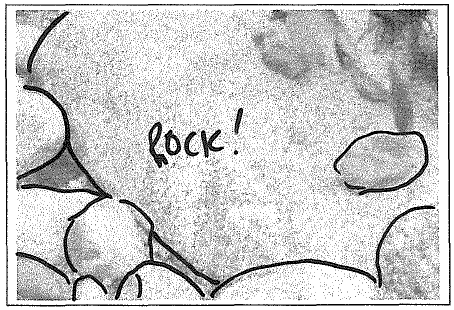
MORE COARSE OBSERVATIONS:
PATTERN OF THE ROCKS CONSTITUENT COLORS
This is the most significant clue to the bedrock origin ofyour rock (Story 2). (Caution: The smaller the rock, the more difficult to recognize patterns.)
What is the general pattern of constituents of the rock?
- Pattern 1: Is there a pattern of layers, of distinctive bands,
- Pattern 2: Is there a vestige of a pattern (you can barely see smushed out layers),
- Pattern 3: Is it a homogeneous pattern (does the pattern look about the same upside down, left to right, comer to comer)?
- Caution: don't be distracted by cracks... layering means a repeated pattern like a stack of magazines. A crack looks like a break. Sometimes lots of parallel cracks look like layers, but usually not.
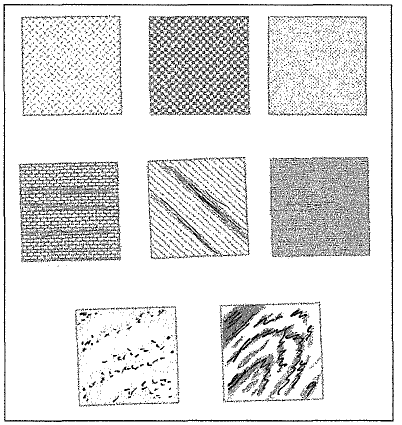
HOMOGENEOUS PATTERN:
The pattern looks much the same when rotated. A homogeneous pattern can consist ofheterogeneous components.
Most IGNEOUS rocks have homogeneous patterns.
LAYERED PATTERN:
The rock units look stacked. (Sometimes individual layers look homogeneous.) Focus on a layer. Ifyou can trace it easily, you probably have a layered rock.
SEDIMENTARY rocks usually are layered.
VESTIGES OF LAYERING:
If the pattern changes as the rock rotates but the layers are not distinctive, the rock may be a METAMORPHIC rock.
The rock's pattern reflects the processes that made it, and the processes are the story.
IGNEOUS rocks were melted. The minerals therefore became well mixed.
SEDIMENTARY rocks were once layers of sediments, so they look layered.
METAMORPHIC rocks have had their fabric altered by heat and pressure but were not melted.
Expect considerable variation and overlap in the appearance of the rock types.
The FINE picture••. what you see at 1 -3 inches or through a hand-lens.
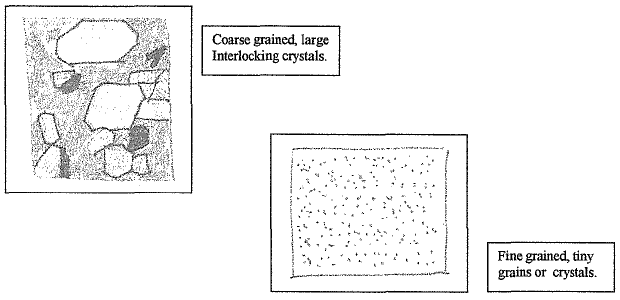
CLUES FOR STORY 2: (what kind of bedrock was the rock eroded from?) These clues may be subtle and may not be consistent. Try to consider all the clues (coarse and fine) before jumping to a conclusion.
Look at the detailed appearance of the rock: the individual grains and crystals, how they are arranged, and the spaces between them.
Look at the fine textures of the rock. Chose an area about an inch by an inch (I-inch square). In your mind, or on a sheet of paper, sketch the details of what you see. Use your hand-lens.
VOIDS VERSUS NO VOIDS
Are you looking at a rock that consists of grains of sediment or mineral crystals? The determining factors will be:
- the presence or absence of void spaces,
- what the individual, tiny constituents look like, and
- how the constituents of the rock fit together.
WHAT TO OBSERVE:
Use your hand-lens. Are the constituents separated from each other by grayish cement or not even held together by cement but grains touching each other with open space in between? Think of the grains as peanut pieces and the cement as peanut butter. Do the particles support each other like the peanuts in ajar? (The particles are called clasts? and the peanut butter is called matrix in geologic jargon.) Or are the particles suspended in peanut butter like chunky peanut butter (matrix supported clasts)? Notice the color of the components of your rock.
Are you looking at a rock with no void space, with no open spaces between its constituents, just crystals welded together?
ANALOGY for understanding clasts, matrix and voids: Peanuts (clasts) and peanut butter (matrix).
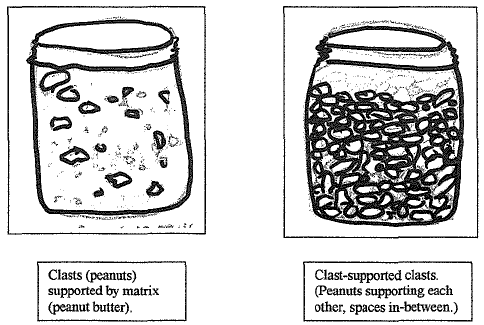
Crystals versus Grains
REMINDER: a mineral is a naturally occurring, inorganic element or compound having an orderly internal structure and characteristic chemical composition and physical properties. A crystal is a homogeneous, solid body of a chemical element or compound, having a regularly repeating atomic arrangement that may be outwardly expressed by plane faces.
Crystals are the outward visible sign of the orderly internal structure of a mineraL Not every mineral is composed of crystals because crystals grow only under special circumstances. Even when the temperature, pressure, and chemistry allow minerals to form, there may not be space or time for crystals to grow. Textbooks such as Dynamic Earlhrefer to minerals as crystalline, meaning the atoms of minerals alligne into characteristic structures which, under the right circumstances will be large enough for us to see them as crystals. But even tiny pieces of a mineral have the orderly internal structure which is determined by the characteristic chemical composition and which gives the mineral its characteristic physical properties. Even when crystals exist in a rock, when that rock weathers, the crystals may get smashed and cease to look like crystals.
The individual particles of the minerals of a rock are referred to generically as grains. For example, a crystalline rock is called fine-grained, or coarse-grained depending on the crystal sizes. Sand grains make up a sandstone. The grain size, determines the rock's texture.
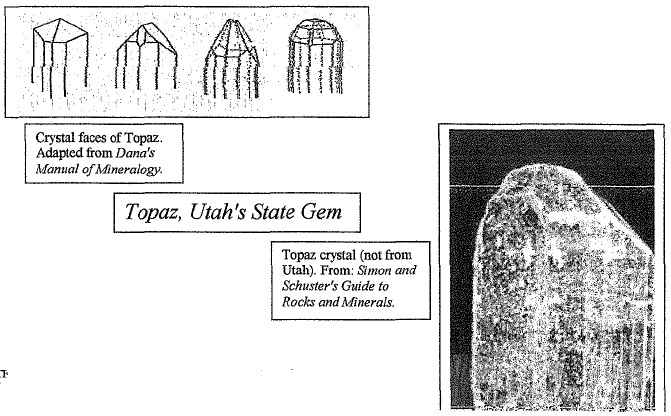
How do the constituents of the rock fit together?
WHAT TO OBSERVE:
- Use your hand-lens.
- Look for boundaries. Try to distinguish the shapes and edges of individual constituents.
- Do you see empty spaces, voids?
- Can you see individual crystals?
- Are they welded to their neighbors, interlocking?
- Are the crystals just one shape and color and apparently just lots of crystals of one mineral?
- Have you a rock made up of several diverse minerals? Notice the color of the components of your rock.
Is your rock:
- fine-grained (most constituents not visible without a hand-lens) or
- coarse-grained (visible grains or crystals even without your hand-lens)?
(-OR-most difficult of all... Are no individual grains or crystals visible even with a hand-lens. Such as white stones with no visible crystals, no visible pattern, or just visible sugary texture with no void space.)
Void spaces: imagine you are a drop ofwater with a mission of flowing through a rock. Would you find it easier to flow through a granite tombstone (igneous) or a sandstone tombstone (sedimentary)? When geologists talk about petroleum "reservoirs" they don't mean pools of oil in huge caverns in the ground. They are often talking about sandstones with innumerable tiny, interconnected spaces filled with liquid hydrocarbons.
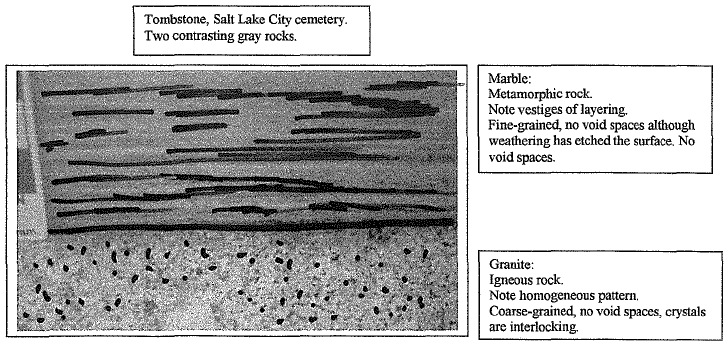
MINERALS The building blocks of rocks
Quartz
Introducing, your friend:
QUARTZ
The name, quartz, comes from German. We don't know much more than that.
Quartz is composed of:
- Oxygen (one part)
- Silicon (two parts)
Appearance:
- Small crystals look like bits of broken glass.
- Larger crystals also look glassy. They seem transparent or dusky.
- Crystals glisten, not flash.
Hardness: 7
- A quartz crystal will scratch a knife blade. A knife blade will not scratch a quartz crystal.
How to recognize quartz crystals in a rock:
- Crystals look like bits of glass or shattered pieces of glass.
- Larger crystals look sort of slick.
- In sedimentary rocks, quartz grains look like bits of sand.
Weathering:
- Quartz resists chemical weathering and is susceptible to physical weathering.
- Therefore, quartz survives the action of weathering processes that destroy most other minerals but weathers into smaller and smaller pieces of quartz until it becomes quartz sand, which is by far the most common kind of sand.
Where you can find quartz in Salt Lake County:
- As crystals in the igneous rocks of Little Cottonwood Canyon (granites) and igneous rocks of the Oquirrh Mountains.
- As the quartz of quartzite boulders carried by streruns from the Oquirrh Mountains and the Wasatch Range.
- As the sand grains of the pinkish -red sandstones of Red Butte Gardens east of the University of Utah. As the fme sand grains of the tan beds of the north end of the Oquirrh Mountains near Pleasant Green cemetery.
- As the loose sand of the sandy soils of Sandy.
- In most of the igneous, metamorphic and sedimentary tombstones of local cemeteries.
Other: So why is quartz your friend? 90% of the rocks that children hand me are loaded with quartz. So seeing quartz is like seeing a familiar, recognizable, friend. It gives me confidence to start figuring out the rock's story.

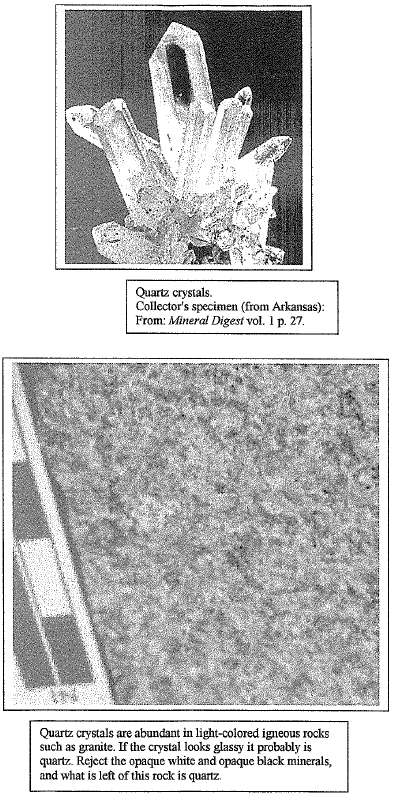
Feldspar
Introducing, the most abundant rock-forming mineral:
FELDSPAR
The name, feldspar, comes from Scandinavian words that means "field stone" perhaps because there were so many in the farmers' fields. (The Dynamic Earth) You can think of feldspar almost like a family of minerals. Feldspars share some common characteristics but they don't all look the same because different feldspars have slightly different chemistry.
Feldspars are composed of:
- Oxygen (lots)
- Silicon (lots)
- plus Potassium and / or Aluminum
- Sodium and / or Calcium
Appearance:
- Individual crystals tend to be opaque, commonly whitish or pink.
- Feldspar crystals usually have "faces" meaning sides that look like walls.
- Some feldspar crystals have faces at right angles, like most buildings.
- Some feldspar crystals have tightly striping.
- In sediments, feldspar grains are uncommon. They tend to be blocky and white.
Hardness: 6 to 6.5
- A knife blade will not scratch feldspar crystals.
How to recognize feldspar crystals in a rock:
- What isn't quartz, and what isn't calcite, usually is feldspar.
- Look for the faces... the walls. Sun will flash off the faces.
Weathering:
- Unlike quartz, feldspars are susceptible to chemical weathering. Feldspars do not survive weathering as identifiable mineral grains. The weathering of feldspars to clays causes the slow disintegration of many rocks. The remains of most of the feldspars weathered from the granite in Little Cottonwood Canyon are now clays in Salt Lake Valley.
Where you can find feldspar in Salt Lake County:
- As crystals in the igneous rocks of Little Cottonwood Canyon (granites) and igneous rocks of the Oquirrh Mountains.
- In many of the igneous and metamorphic tombstones of local cemeteries.
Other: Specific feldspars form at specific temperatures and pressures and chemical conditions. Therefore feldspars have the potential to tell detailed stories of their origin: the kind of molten rock, its temperature, its pressures, its water content. The stories tend to be complex, beyond the scope of this book.
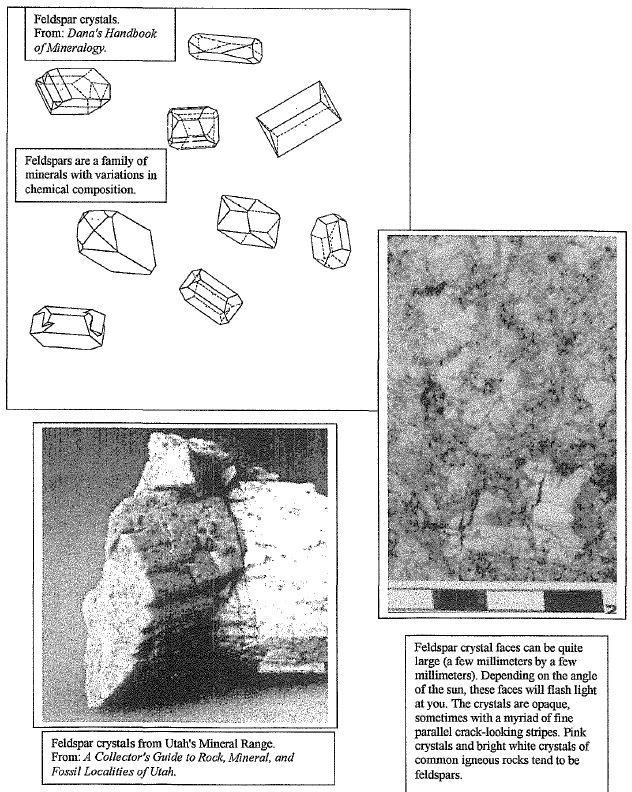
Calcite
Introducing, something different:
CALCITE
The name, calcite, has the same root as calcium and comes from the Greek "chalx" which means "lime" as in limestone.
Calcite is composed of:
- Oxygen (three parts)
- Calcium (one part)
- Carbon (one part)
Appearance:
- Whitish or gray colors.
- Larger crystals also look like prisms of glass with closely spaced stripes.
- Crystals glisten, they are transparent or milky.
Hardness:
- 3 A knife will scratch calcite.
How to recognize calcite in a rock:
- Entire sedimentary and metamorphic rocks may be calcite. These rocks are often shades of gray and white. Most grains or crystals are tiny.. On their most-eroded edges they look sugary.
- Calcite "fizzes" when acid is poured on it (carbon dioxide is produced in the chemical reaction).
Weathering:
- Chemical weathering attacks calcite vigorously.
- The minerals dissolve and water carries the chemicals into the surface-and ground-water system.
Where you can find calcite in Salt Lake County:
- The gray layered rocks of much of the Oquirrh Mountains.
- The gray OS" ridge south of Mill Creek Canyon.
- The limestone quarries in Parley's Canyon.
- The gray -white marble of Alta. As ground-water deposits in caves.
- As clay-sized mud that precipitated out of Lake Bonneville.
- In many white metamorphic and gray sedimentary rocks of local cemeteries.
Other: Remind yourself how you will tell quartz and feldspar from calcite.
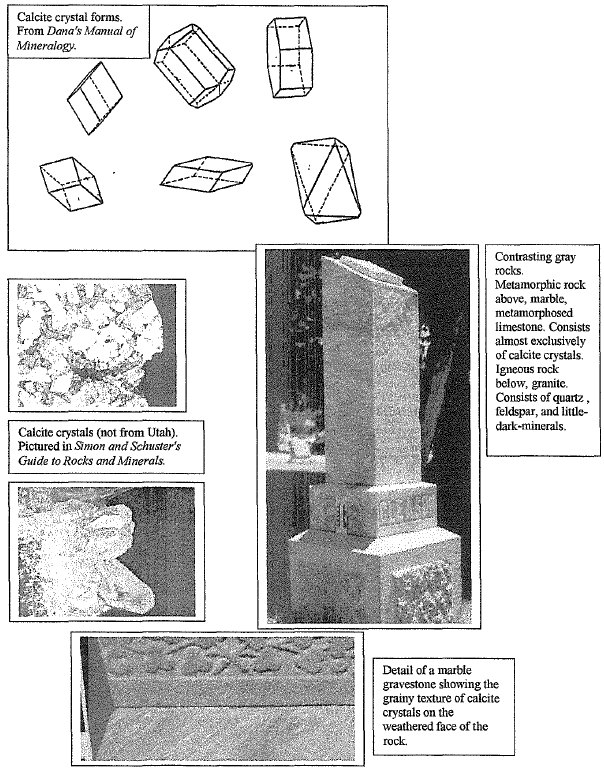
Mica
Introducing, a flaky mineral
MICA
The name, mica, comes from the Latin verb "micare," to shine and noun "mica," meaning "grain" and mica crystals in a stream bed look just like shiny grains.
Mica is composed of:
- Oxygen
- Silicon
- Hydrogen
- Aluminum
- and Potassium, Calcium, or Sodium
- plus iron, magnesium or manganese.
Appearance:
- Mica crystals looks like thin sheets, like stacks of loose paper.
- The sheets have a glassy sheen.
- They are translucent and multicolored.
Hardness: 2to 2.5
- A lmife scratches mica easily.
How to recognize mica in a rock:
- Mica seems to spot you. It twinkles and looks like the thinnest, tiniest sheet of gold or silver.
- Its extraordinarily thin sheets split easily and flex.
Weathering:
- Micas weather into clays.
- They are not resistant and weather relatively quickly.
Where you can find mica in Salt Lake County:
- As crystals in the igneous rocks of Little Cottonwood Canyon (granites) and igneous rocks of the Oquirrh Mountains.
- In the fine sediments of Little Cottonwood Creek in Little Cottonwood Canyon.
- In many igneous or metamorphic tombstones of local cemeteries.
- In wood-stoves that have "windows" of isinglass (mica).
Other: Mica isn't as abundant as quartz, feldspar, or calcite but it's distinctive enough and common enough in igneous and metamorphic rocks to deserve attention. If you only want to memorize three names... the most important ones are: quartz, feldspar, and calcite.
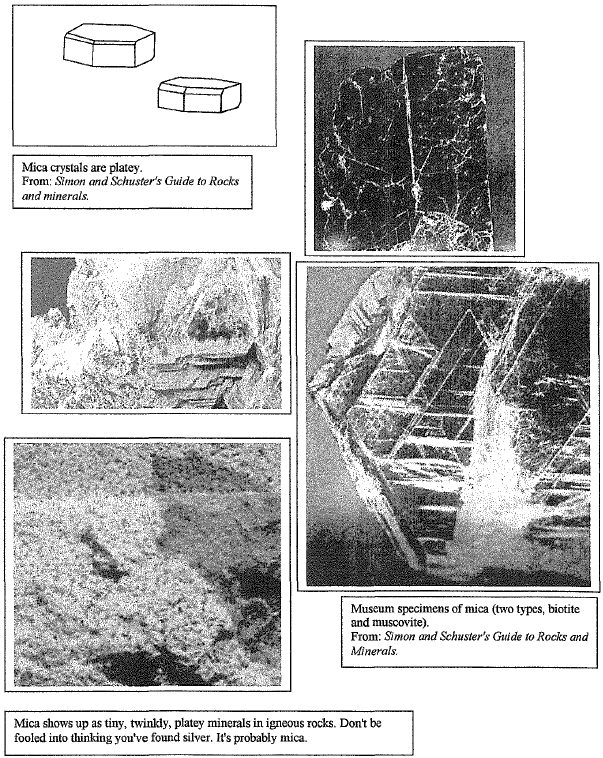
Little dark minerals
Introducing, a couple families of minerals, lumped together as:
LITTLE DARK MINERALS
The name, little-dark-minerals, is purely descriptive. Some bird watchers use the term "little gray birds" to describe small birds that are not easy to identify, so why shouldn't we use "little-dark-minerals" for the same purpose? We want to recognize the importance of a set of minerals rich in iron and magnesium that are chemically and physically similar but difficult to tell apart.
Little-dark-minerals are complex chemically and composed of:
- Oxygen
- Silicon
- plus some iron, magnesium, sodium, potassium, calcium, or aluminum
Appearance:
- Little-dark-minerals look like little dark minerals, 'natch. Crystals are shiny, opaque, and very dark colored such as dark green or black.
- Individual crystals are multi-faced, and often splintery or columnar.
Hardness: usually 5 to 7
How to recognize little-dark-mineral crystals in a rock:
- They look like little dark specks in granites.
- In some decorative stones such as tombstones, the entire rock can be mostly crystals of little-dark-minerals. Some crystals can be large so the name is not always appropriate.
Weathering:
- Little-dark-minerals usually weather into clay minerals.
- The iron component may become oxidized (like rust) or reduced (at the bottom of a lake).
Where you can find little-dark-minerals in Salt Lake County:
- As crystals in the granites in Little Cottonwood Canyon.
- In the igneous rocks of the Oquirrh Mountains In many igneous rocks of local cemeteries.
Other: Little-dark-minerals include literally hundreds offerro-magnesium minerals, which are far more common in the crust that underlies oceans than the crust that makes up continents. So, although they are not common rock-forming minerals of the bedrock of Salt Lake County, world-wide they are very significant.
